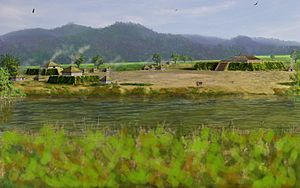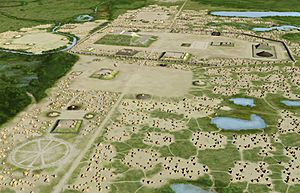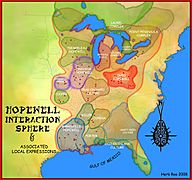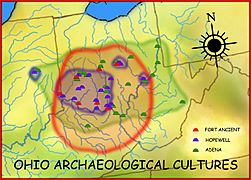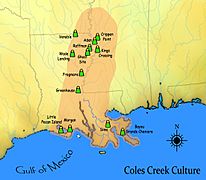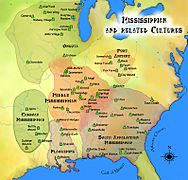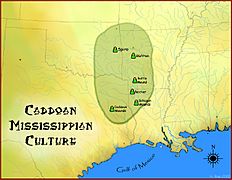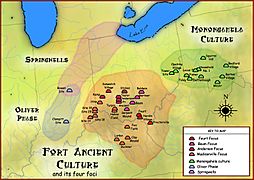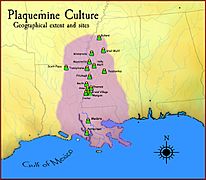Mound builders facts for kids
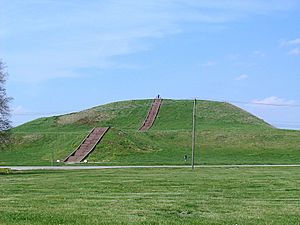
The "Mound Builders" were many different groups of Native American people who lived in North America long ago. They are called "Mound Builders" because they built large earth mounds for over 5,000 years! These cultures existed from about 3500 BCE (when Watson Brake was built) until the 16th century CE. They lived in areas around the Great Lakes, the Ohio River Valley, and the Mississippi River Valley.
Building mounds was a sign that these societies were becoming more organized and complex. Watson Brake in Louisiana, built around 3500 BCE, is the oldest known mound site in North America. It was built by hunter-gatherers, not by farming communities. Later, many mound-building cultures had leaders who directed hundreds or thousands of workers. These workers dug up tons of earth with hand tools and carefully shaped the mounds.
Around 800 CE, the Mississippian culture became very important among the mound builders. Some of their descendants, like the Plaquemine culture and Fort Ancient culture, were still active when Europeans first arrived in the 1500s. The first written descriptions of these cultures came from the Spanish explorer Hernando de Soto's expedition between 1540 and 1542.
Contents
Amazing Ancient Mounds
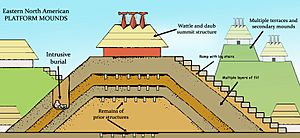
The most famous thing about the Mound Builders was their incredible mounds and other earth structures. These were used for burials, ceremonies, and sometimes as foundations for important buildings. The mounds came in different shapes:
- Flat-topped pyramids or platform mounds
- Cones (flat-topped or rounded)
- Long ridges
- Other unique shapes
These mounds were usually part of large, complex villages. The very first mounds in Louisiana, built around 3500 BCE, are special because they were made by hunter-gatherers. Most later mounds were built by settled farming groups.
The most famous flat-topped pyramid mound is Monks Mound at Cahokia, near Collinsville, Illinois. Cahokia was a major center of the Mississippian culture. Monks Mound was likely the main ceremonial and living place for religious and political leaders. It's over 100 feet (30 meters) tall and is the largest ancient earthwork north of Mexico! Cahokia had many mounds, some cone-shaped or ridge-shaped. It also had strong wooden fences (palisades) protecting the settlement. At its peak around 1150 CE, Cahokia was a city with 20,000–30,000 people. This was a huge population for North America at the time.

Some mounds were shaped like animals, called effigy mounds. The most famous is Serpent Mound in southern Ohio. It's shaped like a winding snake, about 1 to 3 feet (0.3 to 0.9 meters) tall, 20 feet (6 meters) wide, and over 1,330 feet (405 meters) long!
First European Accounts of Mounds
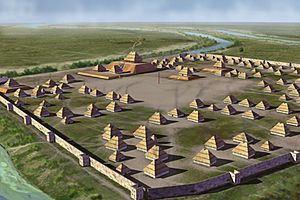
Between 1540 and 1542, the Spanish explorer Hernando de Soto traveled through what is now the southeastern United States. He met many mound-building peoples, who were likely descendants of the Mississippian culture. De Soto saw people living in towns with strong walls, tall mounds, and open plazas. He thought many mounds were foundations for temples where priests lived. Near Augusta, Georgia, de Soto met a queen named Cofitachequi. She told him that the mounds in her land were burial places for important people.
Jacques le Moyne, a French artist who visited Florida in the 1560s, also saw Native Americans using and building mounds. He made paintings showing their lives. One painting showed the burial of a tribal chief, a very important ceremony. The caption said:
Sometimes the deceased king of this province is buried with great solemnity, and his great cup from which he was accustomed to drink is placed on a tumulus with many arrows set about it.
Later, in the 1700s, a Jesuit priest named Maturin Le Petit and a French explorer named Le Page du Pratz met the Natchez people in Mississippi. The Natchez worshipped the sun. They had about 4,000 people and lived in several villages, led by a powerful chief called the Great Sun. Both observers noted the tall temple mounds the Natchez built. The Great Sun's large home was on top of the highest mound. From there, he greeted the rising sun every morning, giving thanks and blowing tobacco smoke in all directions.
Studying Ancient Earthworks
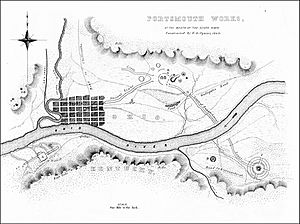
One of the best books about these earthworks is Ancient Monuments of the Mississippi Valley. It was written by Ephraim G. Squier and Edwin H. Davis and published in 1848 by the Smithsonian Institution. Many of the sites they described have since been damaged or destroyed by farming and building. Because of this, their old drawings and descriptions are still very useful to today's archaeologists (people who study ancient cultures).
Timeline of Mound Builders
Early Mound Builders (Archaic Era)
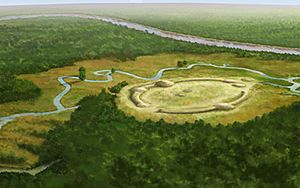
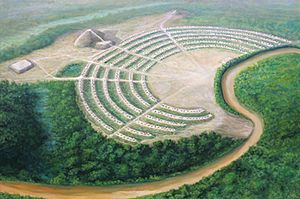
Scientists use radiocarbon dating to find the age of ancient sites. The oldest mound complex in southeastern Louisiana, called Monte Sano, was built around 4500 BCE. At first, researchers didn't think hunter-gatherer groups could build such large structures.
Watson Brake, located in northern Louisiana, is securely dated to about 3500 BCE. It has 11 mounds, from 3 to 25 feet (0.9 to 7.6 meters) tall, connected by ridges to form an oval almost 900 feet (274 meters) across. This means complex earthwork mounds were being built in the Americas almost 2,000 years before the famous pyramids of Egypt! Building at Watson Brake continued for 500 years. Scholars think mound building stopped around 2800 BCE, possibly due to changes in rivers or the environment.
The discovery of Watson Brake showed that ancient American societies, even those without farming, could organize big construction projects over long periods. The people who built Watson Brake were hunter-gatherers who lived in the area seasonally. They mostly ate fish, deer, and plants.
Poverty Point, built around 1500 BCE in Louisiana, is another amazing example from the Late Archaic period. It's a huge complex, over 1 square mile (2.6 square kilometers), with six crescent-shaped earth ridges arranged in circles. It also has three mounds and signs of homes stretching for about 3 miles (4.8 kilometers) along a bayou. Unlike earlier local groups, the Poverty Point culture traded widely, which was a unique feature.
Horr's Island in Florida has a burial mound dating to 3400 BCE, making it the oldest known burial mound in North America.
Woodland Period Mound Builders
The Woodland period began around 1000 BCE. Important cultures from this time include the Adena culture in Ohio, West Virginia, and nearby states. Later, the Hopewell culture built impressive geometric earthworks from Illinois to Ohio. Many other mound-building cultures also existed across the Eastern United States during this time. In some areas, like Mississippi, Arkansas, and Louisiana, the Hopewellian Marksville culture changed into the Baytown culture. This might have been due to attacks from other tribes or climate changes affecting farming.
Coles Creek Culture
The Coles Creek culture (700–1200 CE) in the Lower Mississippi Valley saw a big increase in population and social complexity. By 1000 CE, simple chiefdoms (societies led by chiefs) began to form. Coles Creek sites are found in Arkansas, Louisiana, Oklahoma, Mississippi, and Texas. This culture is thought to be the ancestor of the Plaquemine culture.
Mississippian Cultures
Around 900–1450 CE, the Mississippian culture grew and spread across the Eastern United States, mostly along river valleys. The biggest center where this culture developed was Cahokia in Illinois. There were several regional types of Mississippian culture, including:
- The Middle Mississippian culture at Cahokia
- The South Appalachian Mississippian culture at Moundville and Etowah
- The Plaquemine Mississippian culture in Louisiana and Mississippi
- The Caddoan Mississippian culture in Louisiana, Texas, and Arkansas
Like earlier mound builders, these people built huge mounds for burials and ceremonies.
Fort Ancient Culture

The Fort Ancient culture existed from 1000 to 1650 CE. These Native Americans lived mainly along the Ohio River in parts of Ohio, Kentucky, and West Virginia.
Plaquemine Culture
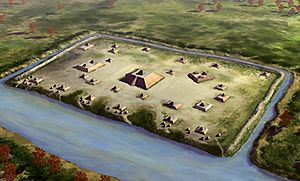
The Plaquemine culture was a continuation of the Coles Creek culture in the Lower Mississippi River Valley. Sites like Medora site, Anna site, and Emerald Mound site are examples. Plaquemine sites were often ceremonial centers without large villages, similar to their Coles Creek ancestors. However, their layouts started to show influences from the Middle Mississippian peoples to the north.
Over time, the Plaquemine culture absorbed more Mississippian influences. By 1350 CE, the distinct Plaquemine culture began to shrink. When Europeans arrived, they found the Natchez Bluffs area as the last pure Plaquemine culture, while other areas had become a mix of Plaquemine and Mississippian cultures. The Natchez people and Taensa people are thought to be direct descendants of the Plaquemine culture.
Why Did They Disappear?
After the 1560s, the mound-building cultures seemed to disappear within the next century. However, there were earlier European accounts, like that of Inca Garcilaso de la Vega (who was part of the De Soto expedition in 1538). He described how Native Americans built mounds and lived their traditional lives. French expeditions in the 1560s also reported staying with Indian societies who built mounds.
Diseases from Europe
Later explorers, just a few decades after mound-building settlements were reported, found many regions empty. The residents had vanished, and the mounds were not being cared for. Historians realized that conflicts with Europeans couldn't be the main reason for this huge population drop, as there weren't many battles.
The most accepted explanation today is that new diseases from Europe, like smallpox and influenza, killed most of the Native Americans. They had no natural protection (immunity) against these new illnesses.
The Fort Ancient culture was also mostly gone by the 1600s, though some parts might have survived into the early 1700s. This culture was heavily affected by diseases in the 17th century.
Myths and Misunderstandings
In the 1800s, people wondered who the Mound Builders were. Some thought they were an ancient, mysterious race with no connection to the Native Americans living there when Europeans arrived. This idea was called the "mound builder myth."
Caleb Atwater, an early researcher, mistakenly thought the mounds were much older than they were. He believed that Native American remains were always found near the surface, while Mound Builder artifacts were found deeper. He also found metal objects, which he thought Native Americans couldn't have made. So, he argued that the Mound Builders must have been a different group of people.
However, we now know that the "Mound Builders" were indeed the ancestors of today's Native American groups. Modern dating shows that mound building happened over 5,000 years, so it wasn't just one group. The spread of the Mississippian culture involved different groups adopting similar ways of life.
For example, the Plaquemine culture is now believed to be ancestral to the Natchez people and Taensa peoples. The Natchez lived in the Lower Mississippi Valley around 1700. In 1729, the Natchez fought against the French colony, and the French destroyed their villages. The remaining Natchez scattered and joined other tribes. The Natchez language became extinct in 1957 with the death of its last known speaker.
Maps of Mound Builder Cultures
Myths About Mound Builders
For a long time, there were many strange ideas about who built the mounds. These ideas often involved mysterious ancient people. Some thought the Mound Builders were:
These ideas are called "pseudoarchaeology" because they are not based on scientific evidence.
The "Giants" Myth
In the 1800s, a popular myth was that the mounds were built by a race of giants. Some newspaper articles even claimed that giant human skeletons, over 9 feet (2.7 meters) tall, were found in mounds. One article from 1886 even said thigh bones were found that would belong to someone 14 feet (4.3 meters) tall! Even President Abraham Lincoln mentioned "extinct giants, whose bones fill the mounds of America."
However, these claims were later shown to be false. By the late 1800s, scientists like Cyrus Thomas of the Bureau of American Ethnology proved that the earthworks were built by the ancestors of Native Americans. Even Thomas Jefferson had excavated a mound and found similarities between the burial practices there and those of Native Americans in his time.
Images for kids
See also
 In Spanish: Culturas de los constructores de montículos para niños
In Spanish: Culturas de los constructores de montículos para niños
- List of burial mounds in the United States
- Prehistory of Ohio
- Southeastern Ceremonial Complex
- Tumulus, mounds (or barrows) of Europe and Asia



